The Microsoft Surface Go LTE Review: Unmatched Mobility
by Brett Howse on January 17, 2019 8:00 AM ESTBattery Life
The Surface Go offers just a 27 Wh battery capacity, which is about half the size of a typical Ultrabook released in the last year. It’s also 40% smaller than the battery offered in the Surface Pro 6 which is the longest life Pro released yet. On the plus side, the smaller display has a lower pixel density, which should help, and the processor doesn’t offer any Turbo modes which would move the power draw of the CPU higher.
As with all of our battery testing, the display is set to 200 nits brightness, to provide an even playing field for all devices. We run several different tests of varying intensity with our 2016 Web test being the most demanding.
2013 Light Web

Our lightest test is our oldest, and the Surface Go isn’t off to a great start. At under eight hours on this test, the battery life is much less than a current generation Ultrabook, and well back of the latest model Surface Pro as well. A couple of years ago, this would have been reasonable battery life. In fact, the Surface Go almost matches the Surface Pro 3 in terms of runtime on this test, but the goal posts have definitely moved.
2016 Web
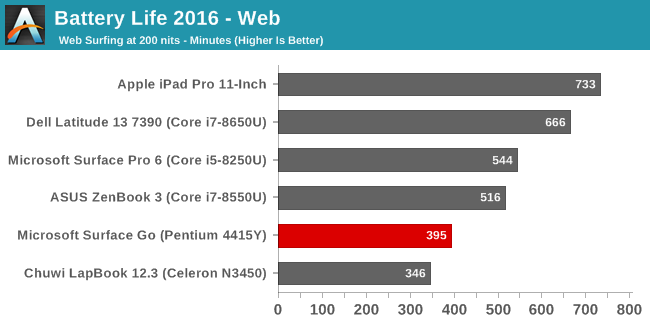
As with the previous test, the Surface Go struggles to keep up to the latest devices in this test as well. The Surface Pro 6 with a Core i5 offers 2.5 hours more battery life in this more demanding workload, which isn’t an insignificant amount of time. The tiny battery capacity hampers the Surface Go significantly here compared to other devices we’ve tested.
Movie Playback
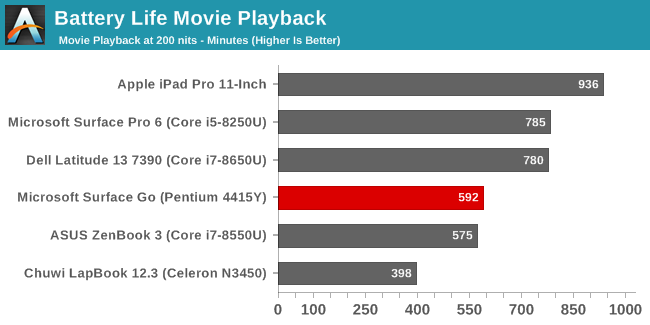
Movie playback is generally one of the best-case scenarios for modern devices since the media playback can be offloaded to the video decode unit, allowing the rest of the processor to go to sleep for much of the time. The Surface Go is still shy of the impressive results seen in the latest Surface Pro, but does get awfully near the 10-hour mark that Microsoft advertises for this device.
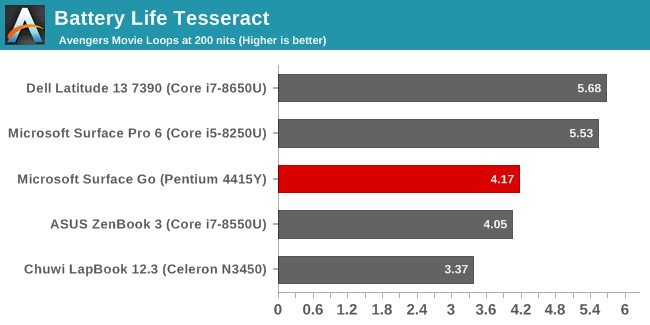
In terms of how many movies can you watch before the device runs out of juice, the Surface Go is pretty stout in this regard, with well over four runnings of The Avengers worth of battery life.
Normalized Results
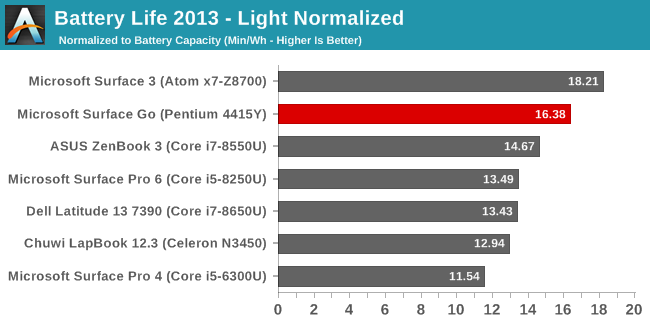
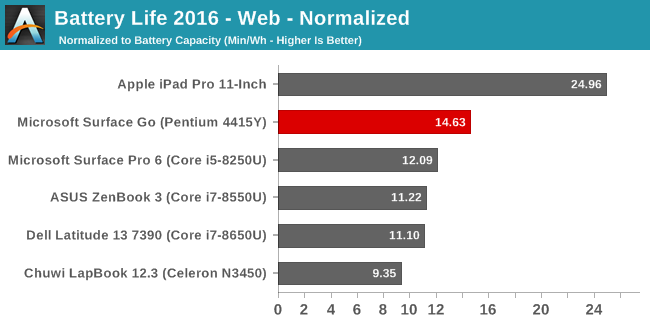
By removing the battery capacity from the equation, we can see how many minutes a device can last per Watt-Hour capacity of the battery. The Surface Go, mostly thanks to the display, does quite well in terms of efficiency. Put another way, on our 2016 Web test, the Surface Go averages 4.1 Watts of power draw with the display at 200 nits, and a Surface Pro 6 draws just a hair under 5 Watts during the same workload. So really, the less than amazing battery life really just comes down to not being able to fit more capacity in the Surface Go. The device is one of the most efficient we’ve tested.
Charge Time
The previous small form factor convertible tablet from Microsoft was the Surface 3, and it took a very long time to charge. Microsoft had outfitted it with a Micro USB port for charging, and then shipped it with just a 13 Watt AC adapter. It seems the company has learned its lesson there, and the Surface Go now offers the same Surface Connect port as the rest of the Surface lineup. It also ships with a 24 Watt adapter.
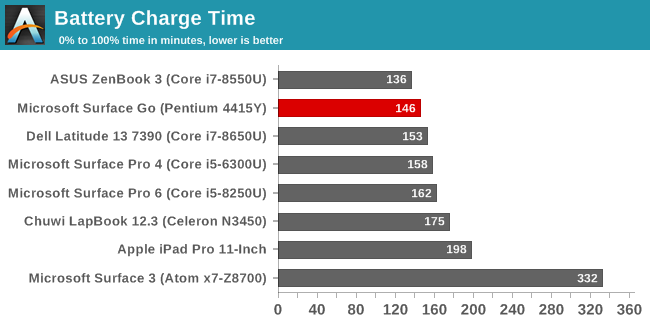
The result is a much better charge time than the Surface 3, and thanks to the smaller capacity battery, better than the Pro as well.
In addition, the Surface Go offers a USB-C port which will also do charging. This is a huge benefit for portable device such as this, since it would let you leave the main charger at home or work, and then use the same charger you use for your phone to top up the Surface Go. Microsoft seems to have an animosity towards USB-C, but this is the perfect device for them to offer it on.










79 Comments
View All Comments
Impulses - Thursday, January 17, 2019 - link
Huh, battery life isn't quite as bad as I thought it was, definitely well under average for the price but I'm still kind of attracted to the unique combination of form factor and capabilities... I don't need a full fledged laptop, but if I'm gonna carry around a convertible like this I'd definitely appreciate x86 compatibility and ease of storage handling vs something like a Chromebook or iPad.How fast can it charge via USB-C?
Archwizard Snim - Thursday, January 17, 2019 - link
I personally checked that USB-PD charging for Surface Go reaches 20V/1A at least, which I think is limited by my cable and charger (or portable battery, for that matter). I once read that the maximum power that goes through the USB-C port is 45W.Even with 20W portable power, however, it's fast enough and doesn't lose the battery even under heavy use. I never even had to worry about battery at all since I always carried the portable USB-PD compliant battery with me.
Smell This - Thursday, January 17, 2019 - link
For reference (and snits and giggles ... )The Bay Trail Preview: Intel Atom Z3770 Tested
https://www.anandtech.com/show/7314/intel-baytrail...
Konservenknilch - Thursday, January 17, 2019 - link
I have the non-LTE version (SSD), very neat little device. Sure, it's not a desktop replacement like its larger siblings, but wonderfully portable and quite speedy.PeachNCream - Thursday, January 17, 2019 - link
Interesting design. Screen bezels don't bother me. Thermal throttling, on the other hand, is an annoyance so I'd happily give up short burst performance for a more consistent experience even if that consistency is considerably slower as a result. That battery life though...I question how the words "unmatched mobility" can be given serious consideration alongside a device that can't even run as long as an old Atom n270-based netbook.TheinsanegamerN - Saturday, January 19, 2019 - link
The short bursts you dislike help to maintain higher battery life numbers. Running slower over a longer period can often wind up using more power in the long run, its why intel started prioritizing turbo boost in the first place.drexnx - Thursday, January 17, 2019 - link
intel needs to stop being ridiculous with their segmentation and let the lower end core stuff turbo in some way, otherwise their (now excellent) atoms will walk all over the bigger cores as we see hereEris_Floralia - Thursday, January 17, 2019 - link
It's hilarious to see Gemini Lake beats Pentium-Y at the same TDP.Lakefield's gonna be very interesting in this area.
Same goes to their Tremont Atoms, if they don't put gimped iGPU in it anymore.
Hopefully AMD is catching up with their newer optimized Raven Ridge.
cpkennit83 - Thursday, January 17, 2019 - link
I assume Gemini at 2.4ghz must be drawing more power than kaby lake at 1.6ghz in the single threaded tests. The 1.6ghz no turbo harness is retarded and even being a lower bin, kaby must be very frugal so far from its upper potential limits.The_Assimilator - Friday, January 18, 2019 - link
> Lakefield's gonna be very interesting in this area.Oh yes. Lakefield absolutely cannot come soon enough.